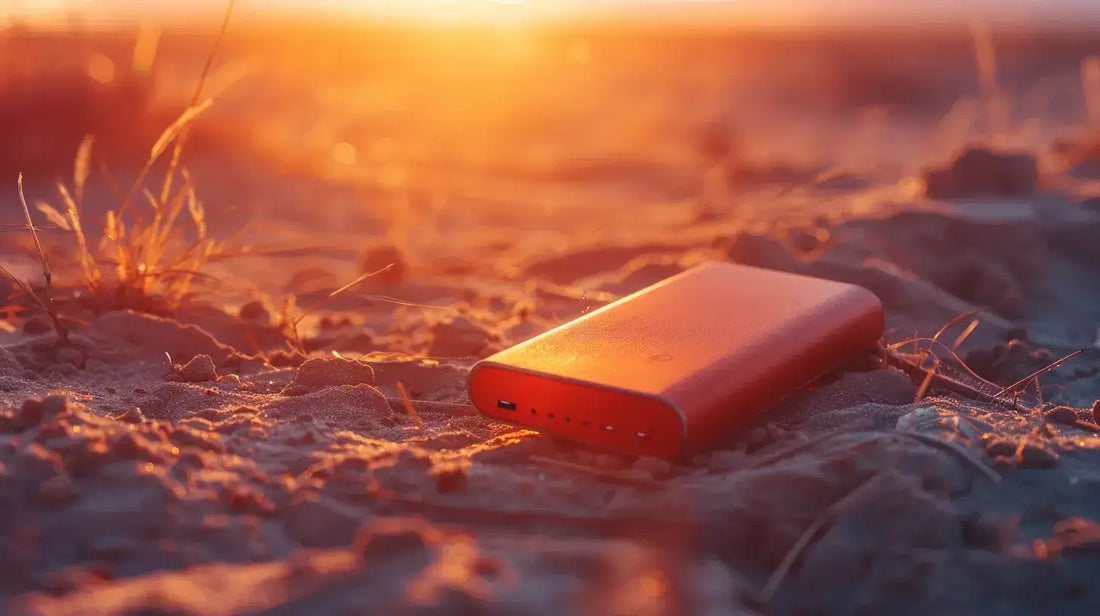
How Temperature Impacts Power Bank Performance and Battery Lifespan
Share
Many users assume that power banks perform consistently in any environment, but temperature plays a crucial role in their efficiency and capacity. Both high and low temperatures can affect charging speed, energy output, and safety. This guide explores how temperature influences battery chemistry, what conditions cause degradation, and how to protect your power bank from extreme weather to extend its lifespan — ensuring you stay charged during every adventure.
Key Insights
- Optimal operating temperature: 0°C to 40°C
- High temperatures accelerate battery degradation and overheating risks
- Cold conditions can cause temporary or permanent capacity loss
- Routine maintenance detects temperature-related performance issues early
- Power banks with robust thermal management systems last longer outdoors
The Science Behind Temperature and Battery Performance
Temperature directly affects the chemical reactions inside lithium-ion cells, which determines how efficiently your power bank stores and releases energy. Understanding this relationship helps users maintain consistent charging performance and extend the battery’s health.
Explore how RUGD engineers its products for extreme durability in the Outdoor Tech Gear Collection, where innovation meets performance.
Common temperature-related issues include:
- Reduced charging speed
- Temporary capacity loss
- Slower quick-charge response
- Increased internal resistance
How Heat Affects Power Bank Efficiency
1. Accelerated Battery Degradation
When exposed to excessive heat, a power bank’s internal resistance increases, lowering voltage and energy efficiency. Storing your device away from direct sunlight or inside vehicles prevents accelerated degradation.
For outdoor enthusiasts, the RUGD Power Brick I is specifically designed to maintain power stability even in high-heat conditions.
2. Overheating and Safety Risks
Excessive heat can lead to thermal runaway, a dangerous condition where a battery becomes unstable. Always ensure proper ventilation while charging and avoid enclosed or insulated surfaces that trap heat.
Learn more about safety-tested portable chargers in RUGD’s Power Bank Range designed for camping and adventure.
3. Preventing Heat Exposure
Practical steps for heat control:
- Store in cool, shaded areas during outdoor use
- Avoid overcharging or leaving connected for long periods
- Use devices with auto temperature regulation systems
For extended outdoor trips or festivals, maintaining hydration also prevents heat stress. See how hydration therapy supports stamina in warm environments at Viva Wellness Drip — a great complement to your rugged outdoor essentials.
How Cold Temperatures Reduce Efficiency
Cold conditions slow chemical reactions in the battery, reducing the electric current output and charge speed.
Temporary vs Permanent Capacity Loss
- Temporary Loss: Power output decreases but recovers when warmed
- Permanent Loss: Long exposure to freezing temperatures can damage cells permanently
To maintain efficiency in winter:
- Keep power banks insulated in inner pockets or thermal pouches
- Avoid charging below freezing conditions
The RUGD Power Brick delivers consistent power across extreme climates, making it ideal for cold-weather adventures and mountain travel.
Other Factors Affecting Power Bank Capacity
Temperature isn’t the only factor affecting performance. Battery age, quality, and charging habits also determine efficiency.
| Factor | Description | Impact |
|---|---|---|
| Battery Age | Older batteries lose charge capacity | Reduced efficiency |
| Charge Cycles | Full discharges wear cells faster | Shorter lifespan |
| Material Quality | Premium lithium-ion construction improves stability | Higher energy retention |
| Charging Habits | Avoid full depletion for longevity | Prolonged durability |
For the most resilient construction and outdoor-ready materials, visit Our Story to see how RUGD products are built to withstand real-world conditions.
Protecting Your Power Bank from Extreme Temperatures
Proper Storage Techniques
Keep power banks in a cool, dry location, ideally between 10°C–25°C. Avoid leaving them in cars or windowsills where heat accumulates. Use insulated pouches during hiking or camping trips to maintain ideal temperature levels.
Charging and Discharging in Varying Climates
- Store in insulated bags during winter
- Avoid direct sunlight when charging outdoors
- Allow ventilation during charging to prevent overheating
For climate-ready charging solutions, check RUGD’s Portable Solar Charger Collection for sustainable energy options that pair perfectly with your power bank.
Choosing Temperature-Resilient Models
Select models with advanced thermal regulation and impact-resistant designs. The RUGD Power Brick I combines an IP67 waterproof rating with wide temperature tolerance, ensuring reliability in deserts or snow.
Maintaining and Monitoring Power Bank Health
Monitor for Signs of Temperature-Induced Wear
Watch for:
- Unusual heat during use
- Slower charging times
- Reduced capacity retention
If these occur, check your device against manufacturer guidelines or consider replacing it with an updated model.
Routine Maintenance Tips
Keep charging ports free of dust and debris to improve airflow. Use only certified cables and chargers to avoid voltage fluctuations. Learn more on maintenance in RUGD’s News & Guides Section, where outdoor tech performance is broken down step-by-step.
When to Replace Your Power Bank
Replace your power bank if:
- Charging capacity drops drastically
- It overheats regularly
- It fails to hold a full charge
These are signs of permanent battery degradation. Upgrading to a temperature-resistant device ensures dependable power supply wherever your travels take you.
Keeping Your Power Bank Ready for Every Adventure
Temperature can silently erode power bank efficiency, but with the right maintenance and model, you can preserve power output and safety.
The RUGD Power Brick I stands out as a rugged, all-weather solution — waterproof, dust-resistant, and reliable from deserts to snowfields.
Stay powered and protected, whether you’re camping, hiking, or exploring. Pair your adventure gear with smart hydration from Viva Wellness Drip to keep both your body and your devices in peak condition.
Frequently Asked Questions
What’s the ideal temperature for using a power bank outdoors?
Power banks perform best between 0°C and 40°C. Staying in this range helps prevent overheating, power loss, and long-term battery damage.
Can I still use my power bank in cold weather?
Yes — but expect slower charging. Keep your power bank close to your body or inside an insulated pocket to maintain warmth and improve performance.
Why does my power bank feel hot while charging?
A little warmth is normal, but excessive heat means it’s struggling with poor ventilation. Always charge on a hard surface and unplug when fully charged.
How can I protect my power bank during camping or travel?
Avoid direct sunlight, keep it shaded, and choose a temperature-resilient model such as the RUGD Power Brick I. Its IP67 rating and thermal regulation make it perfect for outdoor adventures.
Does temperature really affect how long a power bank lasts?
Definitely. Constant exposure to heat or freezing weather shortens battery life. With good storage habits and climate-safe models, your power bank can last up to 40% longer.

